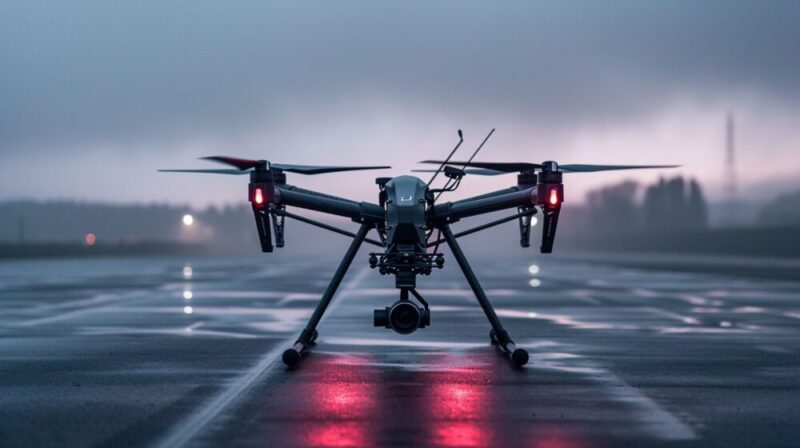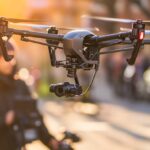In addition to being an increasingly popular hobby across the UK, drone filming and aerial photography presents a huge variety of benefits and opportunities to businesses and brands looking to capture stunning aerial imagery and to produce incredible new perspectives.
There can be quite a steep initial learning curve when it comes to getting to grips with drone technology, and it’s important to use equipment that is both easy to operate and will aid your goals to capture high-quality content to include in your videos.
In this article, I’d like to explore the art of drone filming, beginning with aviation law in relation to drone use

Understanding the Laws, Regulations and Guidelines
With the growing accessibility to drones, we’re hearing more about the misuse of drone flying, including poor airmanship and near misses with other aircrafts (such as Heathrow). As such, there are increasingly strict laws, regulations and guidelines related to drone use within the UK.
Professional drone operators are required to be fully licensed and have a PfCO qualification, and ay individual operating a drone must be aware of the rules set out by the Civil Aviation Authority (CAA). People have been successfully prosecuted from breaking Article 241, Article 94, and Article 95 of the Civil Aviation Authority’s Air Navigation Order, so it’s important that you have thoroughly read, understood and in full compliance with all aspects of the laws surrounding drones.
A few of your primary responsibilities when operating and filming using a drone include:
- Knowing how to fly safely;
- Understanding all legal requirements;
- Ensure that your drone is flying under 400ft, and remains within sight at all times;
- Ensuring that your drone never flies within 50m of any person, building or vehicle outside of your control;
- Never flying near other aircrafts or airports; and
- Ensuring that all captured imagery don’t conflict with privacy laws and GDPR regulations.
It’s also required that you plan contingencies for a variety of different scenarios, including what to do if your drone unexpectedly loses control. Being conscious of any aviation risks are imperative to safe drone use.
You must also plan appropriately for a variety of scenarios, including what you will do if your drone unexpectedly fails or runs out of power. Being fully aware of your surroundings is imperative to safe drone operation.

Piloting a Drone
Before you start using your drone in public, it’s important to spend some time learning how to fly your drone in a safe and capable manner! You’ll need to practice the craft of taking off, keeping your drone steady, manoeuvring through the air, before landing safely. Once you’ve got the basics mastered, you can start to introduce the tricky task of filming whilst flying.
Below are some of our top tips for piloting drones smoothly and safety to achieve cinematic footage.
Carefully Configuring your Drone and Camera
It’s incredibly frustrating to get your drone in the air only to realise that your equipment hasn’t been appropriately configured – we’ve all been there. All drones have a complex variety of settings that help you film efficiently so that you get the best out of your flight experience, and complement your aerial skillsets. Calibrating your drone’s inertial measurement unit (IMU) is vital as it will ensure that you will always know where your drone is, which direction that it’s flying in, and the velocity at which it’s flying at.
Make sure that your camera settings and exposure values are appropriate for your filming conditions to ensure that your images are high-quality, such as your ISO, aperture and shutter settings. If these aren’t set correctly, your compromised footage might not be fixable when you import it into your computer!
Pre-Flight Checklists
Although we love flying our drones, safety is our number one priority when undertaking any given aerial activity – that’s why organisation and preparation are key to effective drone operation, and having a checklist featuring the most important aspects of your setup will ensure that nothing is overlooked.
Your Flight Reference Cards (FRCs) don’t necessarily have to be ultra-detailed, but it should be designed so that you’re confident that you’ve done your due diligence on the project, and can carry out the task safely and effectively.
Check your Battery Levels
Modern drones have the capacity to fly for a maximum of 30 minutes. It’s quite easy to get caught up in the task at hand, and completely lose track of your flight time. Some drones (such as DJI) will begin automatically landing when the battery begins to get low, however there are still a lot of other drones that don’t have this intelligence and will literally crash out of the sky when you run out of battery! If you don’t moderate your flight time, and keep a close eye on your battery levels, that’s an accident waiting to happen.
Beware of ATTI Mode
As drone technology is advancing at such an incredible speed, we’re often unaware that drone operations are heavily automated to reduce the risk of accidents or collisions. Global Positioning Satellites (GPS) and Gyroscopes are key tools that are used to keep drones stable when in flight, so that they stay completely still when there’s an unexpected gust of wind. This is also true for allowing automatic landing techniques that are described in the next section.
There have been instances where drones lose these automated functions due to technical errors, and are forced to revert to something known as ATTI mode. This means that the operator will have to manually compensate for any wind, and especially becomes difficult when attempting to keep the drone steady when attempting to land under harsh weather conditions.
Refining your Landing Technique
One of the trickiest parts of operating a drone is landing safely. Although it might take quite some time to perfect in certain terrains and weather conditions, as an essential aspect of safe drone operation, the time you invest here will be worthwhile. Many drones have assisted landing capabilities, which can do all the hard work for you at the touch of a button.
After you’ve started building up some flight experience as a capable drone pilot, you can begin introducing more complex and advanced aerial manoeuvres, which can create a much more visually interesting and cinematic video.
Capturing Amazing Drone Footage
Being a great drone pilot doesn’t necessarily guarantee that you’ll capture great drone footage. As well as becoming a decent drone pilot, you’ll need to make sure that your equipment is correctly set up to ensure that the footage is correctly exposed, and that you understand how to fly smoothly and consistently to capture professional and smooth looking aerial footage. Below we have a few top tips and techniques to help!
The Art of Panning
One of the easiest techniques for panning involves positioning your drone above your subject to capture the view from a birds-eye perspective that audiences rarely get to appreciate. Alternatively, side-slides involve capturing your subject as it passes by whilst filming at a consistently steady altitude whereas fly-throughs involve carefully piloting your drone through tight areas of small gaps.
Think About the Angles
It’s important to understand that not every position of your drone is a visually interesting angle, as sometimes it’s about understanding composition and depth that makes all of the difference. Look for a specific angle that looks unique and cinematic, and that you feel will hold the attention of your audience.
We also advise that giving yourself some safe margins will really help in the edit, to ensure that you’re not jump cutting between shots, or creating a sequence of shots that feel jarring to watch.
Slow and Steady Wins the Race
Flying fast can sometimes induce some piloting errors, therefore we always suggest avoiding this unless you’re incredibly confident with your piloting abilities. Focus on making a series of small adjustments during each shot rather making erratic movements to fix your mistakes during each shot, as it will result in unsteady and amateurish footage.
Extra Features
A lot of drones have additional features that help pilots capture great looking footage, such as centre points that help frame shots. Additionally filters can be added to certain drone cameras, allowing them to control the amount of light entering the lens without compensating with shutter speed.
Finally, always remember to back up your footage. Keeping your footage stored on a single SD card is an accident waiting to happen. As soon as you’ve completed your flight, take a moment to transfer the data to a hard drive, so you know that everything is safe and secure. It’s a very easy solution to a problem that can cause a lot of money to rectify.





